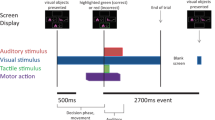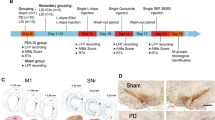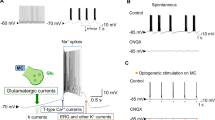Summary
We analysed the firing activity of internal globus pallidus cells in two Parkinson's disease patients undergoing stereotaxic surgery. Both patients showed an advanced rigid-akinetic syndrome with disabling levodopa induced dyskinesias. Apomorphine, intraoperatively administered at doses (1–2 mg) inducing a short but clear clinical improvement without involuntary movements, reduced the pallidal discharge rate by >50% in both patients. An higher apomorphine dose (2.5 mg), tested in one hemisphere, blocked the firing activity with a time course independent from the occurrence of dyskinesias. These finding suggest that the reduction of internal pallidus excitability is one of the mechanisms underlying the efficacy of dopaminergic therapy, but also that changes in other basal ganglia stations are likely to be involved in dyskinesias.
Similar content being viewed by others
References
Albin RL, Young AB, Penney JB (1989) The functional anatomy of basal ganglia disorders. Trends Neurosci 12: 366–375
Benabid AL, Pollak P, Gervason C, Hoffman D, Gao DM, Hommel M, Perret JE, de Rougemont J (1991) Long-term suppression of tremor by chronic stimulation of the ventral intermediate thalamic nucleus. Lancet 337: 403–406
Benazzouz A, Piallat B, Pollak P, Benabid A-L (1995) Responses of substantia nigra pars reticulata and globus pallidus complex to high-frequency stimulation of the subthalamic nucleus in rats: electrophysiological data. Neurosci Lett 189: 77–80
Bergman H, Wichman T, Karmon B, DeLong MR (1994) The primate subthalamic nucleus. II. Neuronal activity in the MPTP model of parkinsonism. J Neurophysiol 72: 507–520
Boraud T, Bezard E, Bioulac B, Gross C (1996) Electrophysiological study of the effects of 1-dopa on the firing pattern of the globus pallidus neurons in MPTP-treated Rhesus monkey. Mov Disord 11 [Suppl 1]: P 761
Chesselet M-F, Delfs JM (1996) Basal ganglia and movement disorders: an update. Trends Neurosci 19: 417–422
Crossman AR (1990) An hypothesis on the pathophysiological mechanisms that underlie levodopa- or dopamine agonist-induced dyskinesia in Parkinson's disease: implications for future strategies in treatment. Mov Disord 5: 100–108
DeLong MR (1990) Primate models of movement disorders of basal ganglia origin. Trends Neurosci 13: 281–285
Fahn S, Elton RL, and members of the UPDRS development committee (1987) Unified Parkinson's disease rating scale. In: Fahn S, Marsden CD, Golsdstein M, Calne DB (eds) Recent developments in Parkinson's disease, vol 2. Macmillan, Florham Park NJ, pp 153
Filion M, Tremblay L, Bedard PJ (1991) Effects of dopamine agonists on the spontaneous activity of globus pallidus neurons in monkeys with MPTP-induced parkinsonism. Brain Res 547: 152–161
Gnanalingham KK, Robertson RG (1993) Chronic continuous and intermittent L-3,4-dihydroxyphenilalanine treatments differentially affect basal ganglia function in 6-hydroxydopamine lesioned rats-an autoradiographic study using (3H)flunitrazepam. Neuroscience 57: 673–681
Hassani OK, Mouroux M, Feger J (1996) Increased subthalamic neuronal activity after nigral dopaminergic lesion independent of disinhibition via the globus pallidus. Neuroscience 72: 105–115
Hutchinson WD, Lozano CA, Davis KD, et al (1994) Differential neuronal activity in segments of globus pallidus in parkinson's disease patients. NeuroReport 5: 1533–1537
Levy R, Hazrat L-N, Herero MT, Vila M, Hassani O-K, Mouroux M, Ruberg M, Asensi H, Agid Y, Feger J, Obeso JA, Parent A, Hirsch EC (1997) Re-evaluation of the functional anatomy of the basal ganglia in normal and parkinsonian states. Neuroscience 76: 335–343
Limousin P, Pollak P, Benazzouz A, Hoffmann D, LeBas JF, Broussulle E, Peret JE, Benabid AL (1995) Effect on parkinsonian signs and symptoms of bilateral subthalamic nucleus stimulation. Lancet 345: 91–95
Lozano A, Hutchinson W, Kiss Z, et al (1996) Methods for microelectrode-guided posteroventral pallidotomy. J Neurosurg 84: 194–202
Parent A, Hazrati L-N (1995) Functional anatomy of the basal ganglia. II. The place of subthalamic nucleus and external pallidum in basal ganglia circuitry. Brain Res Rev 20: 128–154
Sterio D, Beric A, Dogali M, et al (1994) Neurophysiological properties of pallidal neurons in parkinson's disease. Ann Neurol 35: 586–591
Author information
Authors and Affiliations
Rights and permissions
About this article
Cite this article
Stefani, A., Stanzione, P., Bassi, A. et al. Effects of increasing doses of apomorphine during stereotaxic neurosurgery in Parkinson's disease: clinical score and internal globus pallidus activity. J. Neural Transmission 104, 895–904 (1997). https://doi.org/10.1007/BF01285557
Received:
Accepted:
Issue Date:
DOI: https://doi.org/10.1007/BF01285557




